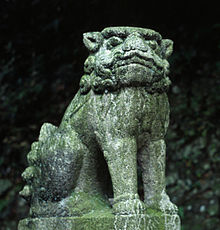|
Komainu
 Komainu (狛犬), often called lion-dogs in English, are statue pairs of lion-like creatures, which traditionally guard the entrance or gate of the shrine, or placed in front of or within the honden (inner sanctum) of Japanese Shinto shrines. Symbolic meaning A twin pair of komainu (construable as "Korean dog"[1]) or two shishi ("lion")/karajishi ("Chinese lion") are the typical stone-made creatures associated with gatekeeping on Shinto shrine grounds.[2][3] The dog and lion pairs are seen as interchangeable.[1] Meant to ward off evil spirits, modern komainu statues usually are almost identical, but one has the mouth open, the other closed (however, exceptions exist, where both komainu have their mouth either open or closed[4]). The two forms are called a-gyō (阿形, lit. '"a" shape') and un-gyō (吽形, lit. '"un" shape') or referred to collectively as a-un.[5] The iconography[1] and symbolism were imported, and not native to Shintoism.[3] The same a-un symbolism is the same one as that associated with the Niō, the two Buddhist gatekeeper deities.[6][7][a] History OriginsIn Asia, the lion was popularly believed to have the power to repel evil, and for this reason it was habitually used to guard gates and doors. The Komainu strongly resemble Chinese guardian lions and in fact originate from Tang dynasty China.[9] The Chinese guardian lions are believed to have been influenced by Asiatic lion pelts and lion depictions introduced through trade from either the Middle East or India, countries where the lion existed and was a symbol of strength.[10] During its transportation along the Silkroad, however, the symbol changed[citation needed], acquiring a distinctive look. The first lion statue in India appears around the 3rd century BC on top of a column erected by King Ashoka.[10] The tradition later arrived in China where it developed into the guardian lion that was later exported to Korea, Japan, and Okinawa. During the Nara period (710–794), as in the rest of Asia, the pair always consisted of two lions.[11] Used only indoors until the 14th century, they were made mainly of wood. During the Heian period (794–1185), for example, wooden or metal pairs were employed as weights and door-stops, while at the Imperial Palace they were used to support screens or folding screens. Heian periodThe custom of placing wooden, and later stone representations of the kara-inu and lions were established no later than the mid-Heian period (tenth century), though precise dating remains uncertain.[12] Perhaps as early as the earlier part of the Heian period (ninth century), the tradition changed and the two statues started to be different and be called differently. One had its mouth open and was called shishi (獅子, lit. 'lion') because, as before, it resembled that animal. The other had its mouth closed, looked rather like a dog, was called komainu, or "Goguryeo dog", and sometimes had a single horn on its head.[13] Gradually the animals returned to be identical, but for their mouths, and ended up being called both komainu.[13] Eventually they were also became apotropaic objects protecting Buddhist temples,[6][12] royal palaces,[12] nobility residences or even private homes.[14] A pair of these dogs are painted on the front walls of the honden (inner sanctuary) at the Kamo-wakeikazuchi Shrine, but such painted examples are a rare, possibly unique.[15] According to one reckoning, the komainu have been used outdoors only since the 14th century.[11] In Japan, too it ended up being installed at the entrance of shrines and temples next to the lion-dog.[16] As a protection against exposure to Japan's rainy weather, the komainu started being carved in stone. Edo periodStarting in the Edo period the komainu began to be placed at the sandō (tr. "avenues of approach"[2] to the shrine) and are now categorized as sandō komainu (参道狛犬, lit. 'entrance-road Komainu'). The much older type are called jinnai komainu (陣内狛犬, lit. 'komainu within [the shrine]'s premises').[17] They can sometimes be found also at Buddhist temples, nobility residences or even private homes. Starting from the Edo period (1603–1868) other animals have been used instead of lions or dogs, among others wild boars, tigers, dragons and foxes. ParallelsFoxes at Inari shrines A variant of the komainu theme is the fox, acting as guardian of shrines dedicated to the Inari deity.[6] There are about 30 thousand Inari shrines in Japan, and the entrance of each is guarded by a pair of fox statues.[18] Often one, and sometimes both, has a sūtra roll, a key or a jewel in its mouth (sūtras are Buddhist texts, a fact which attests to the Buddhist origins of the Inari cult[18][19]). The statues do not symbolize the animals' proverbial malice, but the magic powers they are believed to possess. Sometimes the guardians are painted, and in that case they are always white.[18] White foxes are messengers of the kami, who is sometimes himself believed to be, and portrayed as, a fox.[18] Although visible genitals are rare, the left fox is believed to be male, the right one female.[20] Often the foxes wear red votive bibs similar to those worn by statues of other figures: for example, the Buddhist bodhisattva figure Jizō. In this case, however, the bibs seem to be purely a rite, whose origins are unclear. Okinawan shīsāThe shīsā (シーサー), the stone animals that in Okinawa guard the gates or the roofs of houses, are close relatives of the shishi and the komainu, objects whose origin, function and symbolic meaning they share.[21] Their name itself is centuries old regional variant of shishi-san (獅子さん, lit. 'Mr. Lion').[5] Gallery
See alsoExplanatory notes
ReferencesCitations
General and cited references
External links
|












